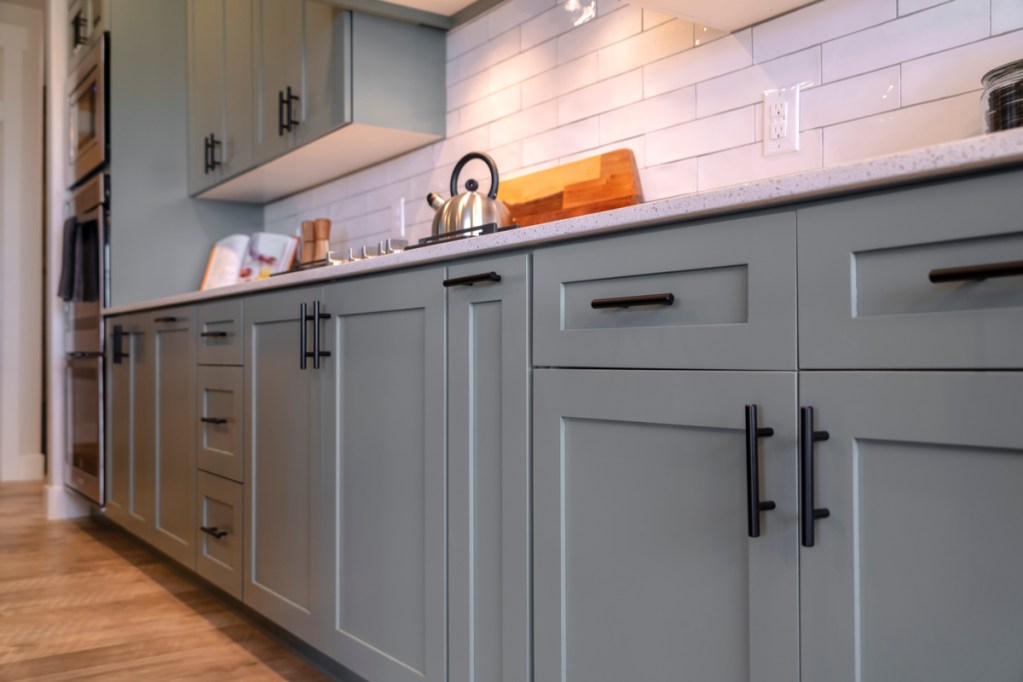As you launch into your kitchen remodel, you’ll have to make several decisions in order to stick to your budget while also creating the kitchen of your dreams. One such decision you’re likely to come across will be choosing whether or not you should install your kitchen cabinets yourself or hire a professional. I
f you’re on the fence about which solution is best for you and your renovation, then we have just what you need. Below, we’re covering exactly how much you can save by taking the DIY route and the steps you need to take to pull off a successful kitchen cabinet installation.
Can you put up your own cabinets?

It is possible to put up your own kitchen cabinets, and in doing so, you could save a lot of money! However, installing kitchen cabinetry yourself is not for the faint of heart. One question we frequently hear from homeowners is, “Are kitchen cabinets hard to install?”
In our opinion, this is dependent on your knowledge of tools and prior remodel experience. For the go-to at-home handyman, installing your kitchen cabinets should be fairly straightforward. Though, it will likely require a day’s worth of hard work and solid measurements.
How much can you save if you DIY your kitchen cabinets?

The average kitchen renovation will typically include professional cabinet installation. The cost of professional help will greatly depend on the local cost of living and the breadth of your project. On average, professional cabinet installation ranges from $4,000 to $9,000, according to Fixr. Of course, the type of wood species, custom cabinetry, the scale of the project, and the age of the home could all impact the overall cost.
Alternatively, putting up cabinets on your own can save you money on installation fees. While you’ll still have to budget for the cabinets themselves and any worksite conditions, the cost should be much more affordable. According to Cabinet Select, the average cost of kitchen cabinets per linear foot can range anywhere from $80 to $1,200 or more.
How to put up your kitchen cabinets

Taking the DIY route for installing your kitchen cabinets can be the perfect budget-saving solution. However, you’ll want to ensure you have all the tools necessary to carry out the project successfully.
What you’ll need:
- Pencil (for marking)
- Level
- Measuring tape
- Stud finder
- Power drill
- Cabinet mounting screws
- Hole saw
- Assembled cabinets
First, measure and mark up the wall
Before you begin installing your DIY kitchen cabinets, you’ll want to measure your space. Determine where each cabinet will go and begin marking the wall using your level and measuring tape to get an accurate outline of where everything will be installed. Next, measure the height of your base cabinets and then find the highest point on your floor. Since not all flooring is perfectly level, this is a vital step.
Draw a level line where the height of the base cabinet will go to use as a guide for the rest of the cabinetry. Take your time with this step, and work your way around the room until all level lines have been outlined. Additionally, this is a good time to mark all studs.
Remove cabinet drawers and doors
Remove all cabinet drawers and doors before you begin installing cabinetry. This will ensure that no hinges or hardware get covered during the painting process. Additionally, this step will prevent injury during installation.
Start with your upper cabinets
Starting with the upper cabinets gives you room to maneuver without bending over or around lower cabinetry. Use a ledger board on the wall to get a straight line for your upper cabinets. Try following the outlines you penciled on earlier to get a leveled surface. Additionally, your ledger board will add support and make it easier to install cabinets if you are doing it on your own.
Drill and fasten the back of your cabinet to the wall. If there is a bow in the wall, shim the space with your level. You’ll likely have to double-check and shim as you go for each cabinet for the best result. Screw the upper cabinets together to attach them in place.
Level and fasten the lower cabinets
Once your upper cabinets have been installed, you can begin work on the lower ones. If you have not yet installed flooring, you’ll need to give yourself about 1/4 inch to 1/2 inch extra room at the base. Line up your base cabinets to your pre-measured line, and fasten the back of the cabinets to that line. Shim if needed.
Depending on the type of cabinets you choose and the style of countertop and backsplash you opt for, you may need to add a filler strip of wood in between the wall and your base cabinets. Be sure to measure twice or more before cutting and installing your filler piece.
Cut holes for pipes
Your sink cabinet should be installed before you cut holes for pipes to ensure everything is measured correctly. Measure the space and use a hole saw to create the spaces for pipe entry. Be sure to allow an extra half-inch of space for your pipes to fit. If you measure precisely, you could find it challenging to fit the pipes through. So, give yourself the extra room. These holes won’t be visible outside the cabinet, so don’t stress about appearances!
Add your hardware
Lastly, you can attach all hardware and hinges. Measure well before pre-drilling holes for your hardware, and ensure everything is level. If you choose to repaint your cabinets, do so before attaching any hardware.
How to find the right cabinets for your kitchen renovation

The easiest way to find the right cabinets for your kitchen reno is to speak with a professional. Heading to your local home improvement or specialty store will allow you to speak to an expert about choosing the right kitchen cabinets for your space. Make sure to take pictures of your existing kitchen layout with you, and don’t forget to jot down existing measurements.
Some homeowners also opt for custom cabinetry. Speaking to a professional cabinet installer can help you develop the perfect custom layout for your needs. Again, it’ll be important to have your existing layout and measurements on hand as you discuss your new cabinetry.
When it comes to cabinet materials, there are several options to choose from. Additionally, you can repaint and refinish many wood cabinets, so be sure to talk to a professional about the best materials for you.
Installing kitchen cabinets yourself is a cost-effective solution, given that you have the experience and confidence to take on this advanced project! Our best advice is to go slowly and measure everything more than once to ensure a level, smooth fit and finish.




